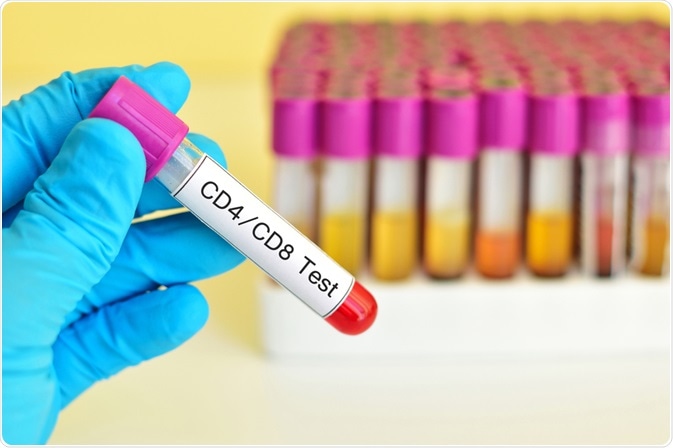A research team from the University Hospitals of Cleveland Medical Center in western Pennsylvania has discovered the existence of myeloid neoplasms (MNs) that can undergo plasmacytoid dendritic cell (PDC) differentiation.
 Image Credits: Jarun Ontakrai / Shutterstock.com
Image Credits: Jarun Ontakrai / Shutterstock.com
This work builds on existing knowledge that PDCs can be divided into two categories: mature PDC proliferations which result in myeloid neoplasms (MPDMN) and blastic plasmacytoid dendritic cell neoplasm (BPDCN). The latter neoplasm only is recognized as a hematopoietic neoplasm.
Atypical hematopoietic neoplasms: PDC differentiation
The groups study present evidence of myeloid neoplasms derived from patients with acute leukemias which encompass a spectrum of PDC differentiation which result in outcomes that do not fit into the categories of MPD MN or BPDCN.
Plasmacytoid dendritic cells (PDCs)
PDCs are a class of specialized dendritic cells that play a role in immunomodulatory functions and antigen presentation. They exert their effect by secreting type one interferons and cytotoxic molecules. PDC progenitors are in common with monocytic and myeloid cell progenitors. Neoplasms, which are abnormal cell expansions, can arise from PDCS; the MPDMN and BPDCN neoplasms.
BPDCNs commonly infiltrate the skin and bone marrow, disseminate, and display an aggressive phenotype. The second type of atypical PDC proliferation cited in the literature in the context of MDs fall under the MPDMN category – although this is not recognized by WHO classification.
Both categories of cells resulting from atypical PDC differentiation are thought to represent two ends of a spectrum of maturation. Consequently, it is likely that other PDC-associated neoplasms will not fit in either of these categories.
A flow cytometry approach to identifying PDC‐associated neoplasms
The team led by Professor Beck sort to query the existence of a range of PDCs at various stages of maturation. The research group used flow cytometry to evidence of their existence. They examined multiple markers of cell identity (CD22, CD123, CD303, and CD304) to determine the subgroups of PDCs.
The group analyzed seven MN patients who presented with PDC proliferations comprising 5-26% of that blood cell or bone marrow. Five of these patients presented with acute myeloid leukemia, one patient suffered from unclassified MN and the final patient presented with a mixed phenotype (MPAL). The patient case described as unclassified was found to contain PDCs across a range of maturity. In all cases, these clinical pathologic findings were distinct from either BPDCN or MPDMN.
Specimens taken from the seven cases were analyzed by flow cytometry. The samples were subject to 4- or 6- color analysis. In both analysis types, all PDCs showed partial to moderate expression of the cell marker CD34 indicating premature PDCs.
Identifying PDC subpopulations
Six of the seven cases exhibited intermediate subpopulations, which evidence differentiation from a population of leukemic myeloblasts. Leukemic myoblast differentiation into PDCs occurs as a result of sharing a common hematopoietic precursor to dendritic cells, monocytes, and myeloid cells.
A previous study by Martin-Martin et al. described three stages of PDC maturation made according to decreasing CD34 expression and increasing expression of CD123, CD303, and CD304. Normal maturing PDC populations we found to make up less than 0.5% of adult bone marrow and are therefore difficult to detect by flow cytometry.
The group found variable expression of CD34 and CD123 in four of the cases which distinguished them from the MPDMN classification. In addition, none of the PDC proliferations satisfied the clinical or pathological criteria for BPDCN.
Given that all seven cases in the series analyzed showed significant PDC populations that could not be classified discretely as BPDCN or MPDMN, the group proposed an alternative term for their classification: “acute myeloid leukemia/ myeloid neoplasm with PDC differentiation”.
Beck’s team further determined that the differentiation of PDC's may occur in the presence of monocytic or myeloid DC differentiation, or as a differentiation lineage possessing a predominant myoblast population.
The group concluded by stating that acute leukemia with PDC differentiation and typical cases of acute myeloid leukemia, NOS, or acute myelomonocytic leukemia are indistinguishable. In addition, the team found no genetic or molecular markers of AML with PDC differentiation, suggesting no genotypic or molecular differences in neoplasms that result.
With the development of flow cytometry techniques, the ability to determine more cases of MNs with PDC is hoped to aid in the determination of molecular and clinical differences between leukemia subtypes
Source
Beck, RC et al. (2020) Flow Cytometry Identifies a Spectrum of Maturation in Myeloid Neoplasms Having Plasmacytoid Dendritic Cell Differentiation. Clinical cytometry. doi: /10.1002/cyto.b.21761
Martin-Martin, L et al. (2009) Immunophenotypical, morphologic, and functional characterization of maturation‐associated plasmacytoid dendritic cell subsets in normal adult human bone marrow. Transfusion (Paris). doi: 10.1111/j.1537-2995.2009.02170.x
Further Reading